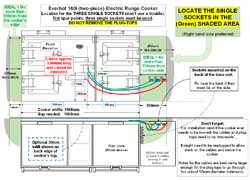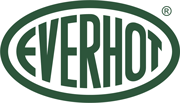(Click here for AGA Installation Questions)
Everhot Installation FAQs
What size are they?
Height and Depth
All Everhots are 900mm high (to the main hotplate / working surface) and are 600mm 'deep' (front to back), excluding the hand-rail.
The lids open to a height of 1530mm (measured to the top of the handle on the open lid); we recommend a minimum clearance of 75mm for 'finger room' to any surface above. (Although if you have less than this and the difference means a lot of work to raise a lintol in an old fireplace then you could choose to accept a smaller gap.)
Please refer to the individual product pages for the dimensioned drawings.
Width
Everhot 60: 598mm wide.
Everhot 90: 890mm wide.
Everhot 100: 995mm wide.
Everhot 110: 1090mm wide.
Everhot 120: 1198mm wide.
Everhot 150: 1490mm wide.
Everhot 160: 1598mm wide.
Please allow a clearance of 3-5mm (at each side) to enable the cooker to be manoeuvered in to place
Clearances Required
Behind
Behind the cooker there will be a gap of 20-30mm to the wall. This is needed for two reasons:
1. The power cable (and 'conduit' containing the control cables for 60, 120 two piece and 150 models) exits the back of the cooker and room is needed to accommodate this without stressing the cable against the wall.
2. When the lid is lifted up the handle (without the gap) would be very close to the wall - the gap gives room for your fingers to wrap around the handle without catching the wall behind.
We have a specially made stainless steel infill that fits to the back edge of the cooker's top-plate to fill the gap and make a neat finish at worktop level. See the sidebar for more details.
To the side
To worktops and/or base units: 3mm to 5mm (each side).
If you're fitting 'real wood' (such as 'end-grain' block) type worktops we'd recommend a 5-10mm gap to the Everhot, particularly at the left side, to help reduce the chance of the wood splitting in the slightly warmer section up to the edge of the cooker.
Above the lids
The lids lift to a height of 1530mm (measured from the floor the Everhot is sat on), we recommend a minimum of 75mm above this so there's room for your hand/fingers when lifting the lid up.
To an Extractor
Everhot don't specify a minimum clearance to an extractor (other than being able to safely lift the lid with room for your hand on the handle).
Refer to your extractor manufacturer's instructions and if they specify a clearance stick to that.
Floor and Plinth
Floor
The Everhot needs the floor to be flat, level, at the same height/level as the finished floor in the rest of the room and be capable of carrying the cooker's weight.
This doesn't necessarily need to be solid, although solid is best.
If you're tiling the floor, laying a laminate or new covering this should be done before the cooker is installed and should extend all the way under it.
Cooker Weights
(Approximate)
Everhot 60: 250kg
Everhot 90i/Plus: 300kg
Everhot 100i/Plus: 350kg
Everhot 110i/Plus: 400kg
Everhot 120i: 400kg
Everhot 120 Plus: 450kg
Everhot 150i: 425kg
Everhot 150 Plus: 500kg
Everhot 160i: 600kg
See below for where the weight is carried.
Floor Types
Suspended Timber Floor
(Floor joists with floorboards nailed or screwed to them.)
This is usually fine. If there's any doubt then an extra 'sleeper wall' could be installed to strengthen the area beneath where the cooker will go.
Floating Floor
Normally a concrete sub-floor with insulation (usually 50mm-75mm thick) laid on top and a fibre-board or chipboard floor on top of that - a laminate / lino / carpet can then be laid as a finish.
These can often support the Everhot but it may well 'wobble' when the doors or lids are opened or closed.
We recommend as a 'best practice' that floating floors are cut out beneath the cooker and made solid. It's quite a job and by no means compulsory but it is the only way to guarantee no 'wobbling'!
'Block and Beam' Floor
(Concrete beams with blocks laid inbetween as a sub-floor, then overlaid with insulation, screed and a floor finish.)
Block and beam floors are normally fine from a load-bearing aspect (sometimes the beam spacing might be reduced to slightly strengthen the area beneath the cooker - consult the specifier/designer to check if you're not sure).
The finish on top of the block and beam needs to be considered, especially if it's going to be a 'floating floor'.
See also the Everhot and AGA floor support page for more info.
Plinth
A special plinth is not normally needed for the Everhot (the cooker is 900mm high to the main working / hotplate area.)
If your worktops are higher than this and you'd like the cooker to finish at the same height then you will need to install a suitable plinth to raise it up by the correct amount.
Load-bearing
The Cooker's weight is carried by two hardwood strips 20mm wide and mounted 15mm in from each edge of the cooker. They run the full depth (front to back). This is the only part that would need raising or supporting to lift the cooker up; however you will then see a 'gap' so a facia is recommended to provide a neat finish.
Raising the Everhot for higher worktops.
Since the weight of the cooker is carried on the 'skids' this is the only part that needs lifting up.
See the photos below for an example of an Everhot 150i on raised plywood strips.
Extractor / Chimney / Flue
Does the Everhot need a flue?
Put simply - no!
There's no chimney, flue or vent from the Everhot so it can be postioned anywhere in the kitchen.
Any steam or cooking smells are vented in to the room, just like most cookers so it is recommended (although not compulsory) to have an extractor above if you want to exhaust these to outside.
Clearance to an extractor over the Everhot
Electrical Requirements
Does the Everhot really just plug in?
Yes!
The Everhot 60, 90 Plus, 100 Plus and 110 Plus all just need one single socket outlet and have a maximum electrical load of 2.8kW (about 13 amps).
All models up to 150cm wide with an induction hob (90i, 100i, 110i, 120i, 150i), the 120 Plus and 150 Plus need two single sockets - with a maximum load of 2.8kW per socket.
The 160i needs three sockets.
Single sockets, not a double?
The Everhot uses a low-powered connection and its 'heat storage' side only needs one 13amp socket to plug in to. (Its maximum load is 2.8kW.)
The models (up to 150cm wide) with integral induction hob need a second 13amp socket (even the larger three-zone induction hob on the 120i and 150i only need a 13amp connection), the 160i needs three 13amp sockets.
When installing the cabling for the Everhots needing two or three sockets it's recommended to have two single sockets outlets rather than a double.
Why not a double?
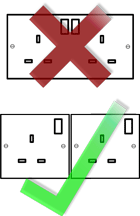
Single socket outlets are usually rated at a maximum load of 13amps (or 3kW).
Double sockets are also usually rated at 13amps, crucially though that's shared between the two outlets: 3kW in one and nothing in the other, or 1.5kW in each - you get the picture.
"But I plug the toaster and kettle in a double socket now, what's different?"
Indeed - and you'll normally get away with that since neither is on for long so there's not enough time for excessive heat to build up and cause harm.
It's fairly unlikely with an Everhot too but since it can draw close to 2.8kW for a reasonable length of time on both (or all three) sockets it could (slim chance, but it could) lead to heat-damage on a double outlet.
Best Practice?
Fit two (or three) single outlets. All are fine to carry the full 2.8kW for at least as long as they would ever need to and should be fine. Belt and braces we know but better safe than sorry!
Electrical Socket Positions
The Everhot 60, 90 Plus, 100 Plus and 110 Plus models just need one 13amp socket outlet.
The 'i' (Induction) models, 120 Plus and 150 Plus need two 13amp socket outlets and the 160i needs three single sockets (these must be single sockets, don't use a double!)
See the diagrams (click for a larger version) for the best positions and cable lengths.
Heating and Hot Water
Can the Everhot do the heating?
No
The Everhot will help heat the room it's in - it is a 'heat-storage cooker' designed to radiate heat to the room. (See roomheating effect for more information.)
It isn't designed to be connected (or plumbed in) to the heating.
And the hot water?
The Everhot isn't available with a hot water boiler - it's better to use an immersion heater in the cylinder instead.
This avoids the complexity of a boiler in the cooker and the pipework between it and the cylinder.
(After all, it's the same fuel doing the same job but without the extra componentry and additional heat-loss from the circulating pipes.)
Separate Control Box for EVH 60 and EVH 120 Plus Models
The Everhot 60 and Everhot 120 Plus models have separate control boxes (the 60 has one, the 120 Plus has two).
-250px.gif)
These need to be accommodated in your plans. Some prefer to have it set on the worktop, others like to put it in the cupboard to the side of the cooker.

A couple of things to bear in mind:
You will need to get to the control box to change oven or hotplate temperatures, or to change the 'ECO' programme. It's not like an ordinary cooker where you have to turn it on and off every time you use it, but you will need to access it every now and then.

The control box has a cable coming in to it from the socket it's plugged in to, and another (larger) 'conduit' taking the power and sensor wires to the cooker itself.

If you need to drill a hole for both the power cable and conduit to fit through then we'd recommend 60mm diameter, and bear in mind there's only 1.5m - 2.0m of cable to reach from the box to the back of the cooker (quite low down) so the control box needs to be on the worktop or in the cupboard immediatly to the side of the cooker.

Can the box go on the wall?
No, it's not possible for the conduit to reach the cooker from a wall unit, and it's not possible to mount it on the wall.

Width: 220mm
Depth: 145mm
Height: 157mm
Timing - When's best to install the Everhot?
When you're having a new kitchen installed
Generally we recommend installing the Everhot just before the new kitchen units are fitted.
We'll need the information from your kitchen designer / fitter on the position for the cooker, the worktop height and whether you're having any upstand or backsplash fitted behind it (so we can position it to allow for these).
If your electric sockets are to be mounted in a base unit to the side of the Everhot (which is recommended) then we can leave the cables ready for the kitchen fitters to drill a hole for them to be drawn through and plugged in as the furniture is installed.
In an Existing Kitchen
The Everhot comes fully assembled so can be fitted in to an existing aperture usually without a problem.
The floor needs to be level and it's important to make sure things like old gas connections and water pipes aren't in the way (they'd push the cooker forward and leave a gap behind if left in place).
(If you're having a new kitchen and have already installed the kitchen furniture then we can still normally install the cooker, it's just that it's easier for us without them in place, and your kitchen fitters can normally make a neater finish when working 'up to' the cooker rather than leaving a [bigger] gap for us to fit the cooker in to.)


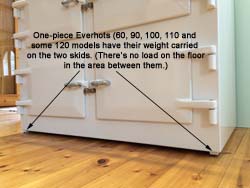










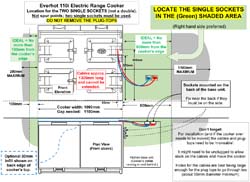
-250px.gif)
 socket location diagram250px.jpg)
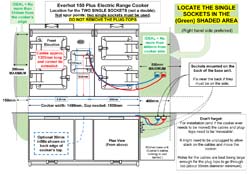
 socket location diagram250px.jpg)
 socket location diagram250px.jpg)
